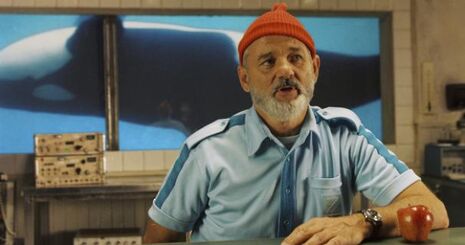Close-Up: Wes Anderson
Perdi Higgs celebrates an auteur whose cinematic confections have hidden depths of realism

To me, the most powerful films are ones that create a little world that you are able to climb inside. The work of director Wes Anderson is dedicated to building a place of aesthetic perfection that you can fully immerse yourself in. His style is centred upon his distinct cinematography. Its warm colour palette and symmetry make each film feel like pages of an old weathered graphic novel. It is a particularity that breeds a sense of comfort, and it is what has given Anderson his ‘signature style’.
And it really is a style. In 2007, The Darjeeling Limited contained luggage designed by Louis Vuitton especially for the film. Having created short films for Prada, Wes Anderson went as far to design his own café, Bar Luce, located at the Fondazione Prada in Milan. I imagine that each teacup is the perfect shade of pink, matching each perfectly cubic sugar lump.
“The work of director Wes Anderson is dedicated to building a place of aesthetic perfection that you can fully immerse yourself in”
Such detail is his signature, and although this attention to visual perfection creates a pleasing film-watching experience, it is often a source of criticism. Does an attention to the visual mean that the rest of the content must be somewhat neglected? Can a filmography dedicated to this consistent aesthetic truly commit to any true substance?
Anderson’s cinematography works in harmony with his dialogue and overarching narrative, and doesn’t overshadow it. In his attention to visual detail, each film creates a rich frame for which the narrative and dialogue can be somewhat stripped down. The intricate imagery contrasted with open, often blunt dialogue is what draws me so much to Wes Anderson’s work.
This is the thing about Wes Anderson’s films: while there are so many particularities that give them their style, I would argue that their brilliance is often in their simplicity. And it is his intricate cinematography that allows space for this simplicity elsewhere. The characters within Anderson’s films are somewhat extreme, often almost caricatures. But they are also incredibly honest. It’s almost a trap – a chocolate box viewing experience that manages to interweave sentimentality and realistic emotion within an almost-unreal setting.
“Sometimes it’s a lot easier to articulate an emotion in music and glances than in words, and that’s what Wes Anderson proves so well”
In 2004’s The Life Aquatic with Steve Zissou, the protagonist, Zissou (portrayed by Bill Murray), is tracking down a mysterious underwater creature that ate his best friend. When he eventually encounters the creature, there is an incredible moment of tranquillity, as Zissou and his team watch this giant animated creature swim around the ocean. Anderson turns the camera on the team, as you watch the grief in Zissou’s eyes – Anderson encapsulating the quiet tragedy of the story. All of this comes through human silence, though accompanied by the lucid murmurs of Sigur Ros’s Staralfur. In lieu of speech, music will suffice to lead the audience to where the film intends you to go, a moment of simplicity in a seemingly visually-complicated filmography. While The Life Aquatic...’s plot is fantastical, and the creature a neon imagination, the emotions are real.
Soundtracks are central to the power of Anderson’s work, using them as a powerful communicative force. When Margot Tenenbaum steps off the bus and is met by her love-interest, Richie, Nico’s ‘These Days’ plays gently in the background as we pan between the two characters. The moment is dialogue-free, yet romantic, sad and happy. You look at this 15-second scene and see ‘love’, without a single word shared. Sometimes it’s a lot easier to articulate an emotion in music and glances than in words, and that’s what Wes Anderson proves so well. It is what makes each Anderson film an immersive experience.
The characters are often obtusely simple, often obnoxious and difficult. And in this, they are likeable, honest and engaging. I once went to a Halloween party where there were two people dressed as Margot Tenenbaum. It isn’t just because the aesthetic of a fur coat, tennis dress and a lit cigarette is one to be admired. It is because she represents the blasée cool girl. She is a cinematic creation that embodies the fun of film, the ability to make ridiculous versions of real people.
Although Wes Anderson creates his own worlds, his characters are still recognisably human. His films may be an escape, but we can still relate to the content, framed within this his picturesque tableaux of colour, fashion and music
 News / Eight Cambridge researchers awarded €17m in ERC research grants27 December 2025
News / Eight Cambridge researchers awarded €17m in ERC research grants27 December 2025 News / Downing investigates ‘mysterious’ underground burial vault 29 December 2025
News / Downing investigates ‘mysterious’ underground burial vault 29 December 2025 Lifestyle / Ask Auntie Alice29 December 2025
Lifestyle / Ask Auntie Alice29 December 2025 Sport / Hard work, heartbreak and hope: international gymnast Maddie Marshall’s journey 29 December 2025
Sport / Hard work, heartbreak and hope: international gymnast Maddie Marshall’s journey 29 December 2025 Interviews / Meet Juan Michel, Cambridge’s multilingual musician29 December 2025
Interviews / Meet Juan Michel, Cambridge’s multilingual musician29 December 2025








